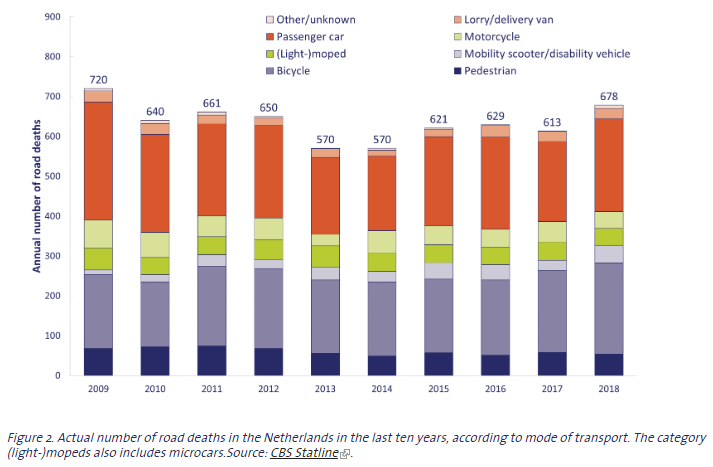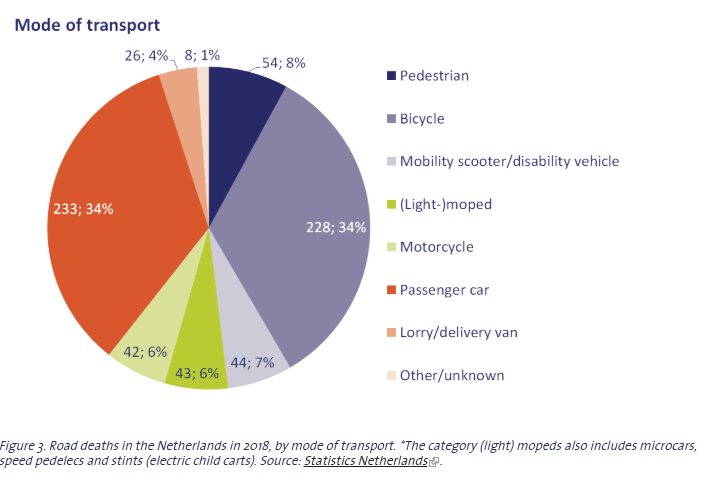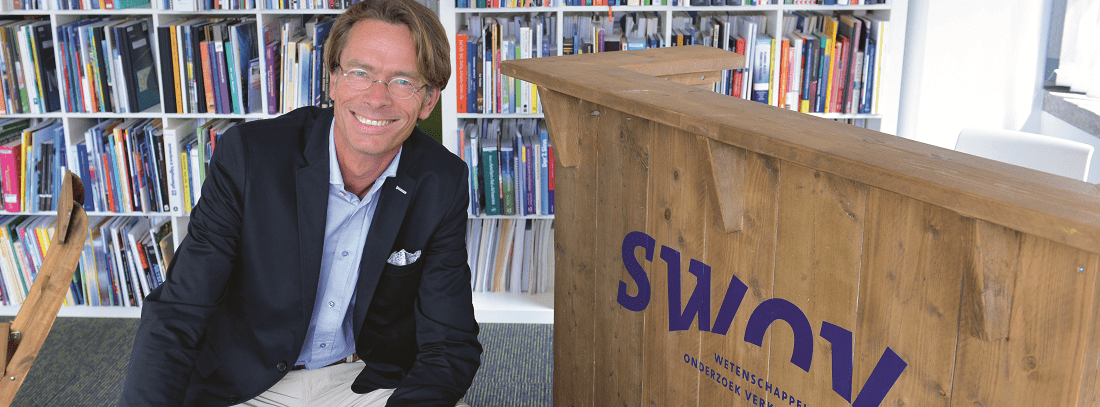SPEEDING UP THE MOBILITY TRANSITION: Peter van der Knaap, SWOV
'To improve road safety a change of behavior is necessary.'
With the continuous growth of the population and ongoing urbanization there are numerous mobility challenges. Sustainability, safety and societal impact are amongst our daily concerns. We need to speed up the mobility transition to keep up with the fast changing global dynamics, which requires inventive approaches and better solutions. In this series we share inspiring and innovative cases from all over the world. Dr. Peter van der Knaap leads the Dutch scientific institute for road safety research, SWOV. Based in The Hague, its purpose is to contribute to safer road traffic. But how do they speed up this mobility transition?
-‘The number of road deaths among cyclists has not really decreased.’-
‘Although we were once firmly in the top three in the world, a lot still remains to be done with regards to road safety in the Netherlands. In fact: Dutch road safety has deteriorated in the last decade. Compared to the official numbers of road deaths reported by other European countries, the actual number of road deaths in the Netherlands in 2018 ranked eleventh in Europe. The number of road deaths in 2018 was 678, that is 10% more than in 2017. While government pledged that we should reduce this figure to no more than 500 by 2020. Most striking: until 2014 the number of road deaths in car occupants declined, but from 2015 the number increased again. The same accounts for the number of pedestrians. The number of road deaths among cyclists has not substantially decreased with the highest in 2018 of 228 and many of the cyclists killed rode pedelec bikes.’

-‘Traffic crashes occur due to a combination of three factors.’-
‘To improve safety we need to find out where it still goes wrong. A traffic crash does not happen because only one thing goes wrong; it is always a combination of factors: characteristics of the road, the vehicle and the human being. Together they form traffic which is a very complicated system. The road can be slippery, the driver tired and the vehicle’s tires can be worn out. All together this contributes to the likelihood and severity of the actual crash and injuries, possibly fatal.’
‘Our recent analysis on the cause of fatal traffic crashes on highways in 2017 showed there were 63 fatal road crashes on national roads. The most common crash types were:
1) Collisions with an obstacle in the roadside, such as a tree or ditch (n = 25)2) Rear-end collisions (n = 21), half of which are in the tail of a traffic jam
3) Frontal collisions (n = 8), of which five on single-lane roads
‘These crashes were caused by a combination of carelessness or even deliberate risk behavior of the road user and a road layout that offers little room for human error. A vehicle defect also played a role in a small part of the crashes. The seriousness of the outcome of the crash was largely determined - in view of the large proportion of roadside crashes - by the design of the roadside.’
‘Thanks to analyses like this we can make improvements. The most promising measure for a significant reduction in the number of fatal crashes on national roads is aimed at an obstacle-free layout of roadsides. We need roadsides with a large obstacle-free zone that matches the speed limit on site, in combination with a flexible screening structure at the end of the barrier-free zone (Van Petegem, Louwerse & Commandeur, 2017a). Traffic enforcement also needs continuous effort. In all these domains, innovation can help to find more cost-effective solutions.’
-‘A third of the people killed in crashes on national roads were not wearing a seat belt.’-
‘But there was something even more striking to me that was discovered in this research. A third of the people killed in crashes on national roads in the Netherlands were not wearing a seat belt. While 10 years ago 97-98% of motorists in the Netherlands were wearing a seat belt, there currently appears to be a group of people who put the belt neatly into the click, but then sit on top of it to bypass the seat belt reminder. Doesn’t this sound crazy? Of course, there will always be people that are tempted to take a risk, but we need to do everything we can to change that behavior.’

‘Also alcohol use and speeding increase the risk of a fatal crash. Plus there is a completely new challenge in the Netherlands: the use of nitrous oxide while driving. This year alone police have noted 960 traffic incidents that involved nitrous oxide. We want to make sure people act as safe as possible through a change of behavior and innovations. To remind people to wear a seat belt, we can develop a system where the seat belt realizes it is clicked in the co-driver’s seat instead of the driver’s seat.’
-‘We need to make roads safe and minimize damage made.’-
‘But what can we do to improve the safety of millions of people? We recently updated the Dutch Sustainable Safety Vision, firstly developed in the 1990s. The objective? Maximum road safety for everyone, with a casualty-free traffic system as the ultimate ambition. What does the road look like now and what do we need? In order to adapt the traffic system and achieve maximum safety, human needs, competences, limitations and vulnerability should be the primary starting point. Plus, we need to make sure that the damage is as minimal as possible, might something happen. Roads and cycle paths that are ‘forgiving’ to minor mistakes are important: a slight steering error should not lead to serious injury. And we need to organize it well, all together. We need commitment and responsibility. From manufacturer, road authorities and government to the driver.’
The vision for sustainable road safety is based on five principles:
1) FUNCTIONALITY of roads;
2) BIO)MECHANICS: limiting differences in speed, direction, mass and size, and giving road users appropriate protection;
3) PSYCHOLOGICS: aligning the design of the road traffic environment with road user competencies.
4) Effectively allocating RESPONSIBILITY;
5) LEARNING and INNOVATING in the traffic system.
-‘Innovation helps us to improve road safety, but we need to stay alert.’-
‘We need innovation. But we also need to stay smart and not forget the actual driver. What does our future road look like with highly autonomous and even self-driving cars? New developments and new systems can be very helpful in achieving the ambitions for a safer road. Going back to bahavior and what humans can and cannot do well, how do we prevent from becoming over-dependent on these systems? Modern safety systems also offer ease. But the use of advanced cruise control systems could have a negative effect on the alertness of the driver taking part in traffic. One of our simulator studies actually implied that it could take at least six seconds for experienced drivers to safely take back control in an autonomous vehicle. I fear some people might not be alert enough when driving a semi- autonomous car. This is important information for our future road safety.’
‘The infrastructure is not 100% safe and can be inherently safer. We have a lot of challenges to face. Population is growing thus more people are taking part in traffic, and as our population is becoming older and, hence, more vulnerable, we need to be ready for more inclusive modes of transportation. Therefore, I argue it is important to put road safety higher on the agenda. We have become smarter in learning and doing research, but there is a lot to be done to save lives. In this endeavor, industry must play a big part.’
(Header image: Eimer Wieldraaijer)
Share your story
Do you have an innovation, research results or an other interesting topic you would like to share with the professionals in the infrastructure, traffic management, safety, smart mobility and parking industry? The Intertraffic website and social media channels are a great platform to showcase your stories!
Please contact our Sr Brand Marketing Manager Carola Jansen-Young.
Are you an Intertraffic exhibitor?
Make sure you add your latest press releases to your Company Profile in the Exhibitor Portal for free exposure.





